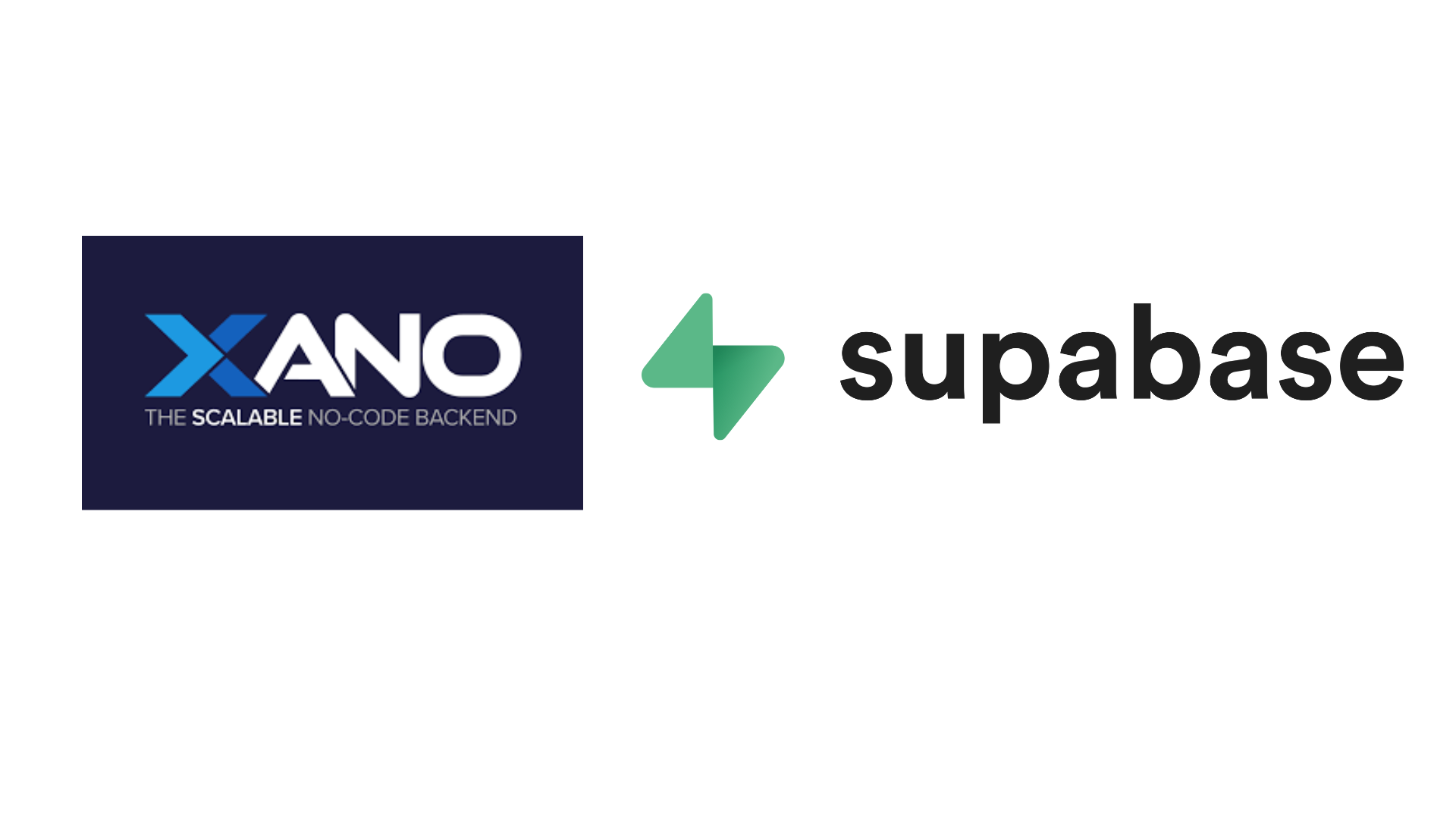

Supabase vs. Xano : Choisir le bon backend pour votre projet
Publié le 17 février 17, 2025
Par Christiam Muñoz. 9 minutes de lecture

Dans le paysage actuel du développement, qui évolue rapidement, le choix de la bonne solution de backend est essentiel pour créer des applications évolutives, efficaces et faciles à maintenir, y compris des applications web. Parmi la myriade d'options disponibles, Supabase et Xano se distinguent comme des concurrents de premier plan, chacun offrant une approche unique du développement de backend. Supabase, une alternative open-source à Firebase, fournit aux développeurs une suite d'outils pour construire rapidement des applications évolutives, en s'appuyant sur PostgreSQL comme base de données principale. Xano, quant à lui, se présente comme une plateforme "Backend as a Service" (BaaS) qui met l'accent sur la création d'API NoCode et la gestion de bases de données, s'adressant aux utilisateurs qui préfèrent construire des fonctionnalités backend sans se plonger dans le code.
Bien que les deux plateformes visent à rationaliser le processus de développement, elles répondent à des besoins, des niveaux de compétence et des exigences de projet différents. Cet article propose une comparaison complète de Supabase et de Xano, en explorant leurs principales différences, leurs caractéristiques clés et les facteurs à prendre en compte lors de la prise de décision.
Différences fondamentales
Il est essentiel de comprendre les différences fondamentales entre Supabase et Xano pour déterminer quelle plateforme correspond le mieux aux objectifs de votre projet.
Exigences en matière de codage : Xano se distingue par son approche NoCode, qui permet aux utilisateurs de construire des logiciels évolutifs sans avoir à écrire de code. Supabase, bien qu'offrant une interface conviviale, nécessite des connaissances en codage, en particulier en SQL et en développement de backend.
Backend : Xano fournit une solution backend tout-en-un, comprenant un serveur évolutif, une base de données flexible et un constructeur d'API NoCode. Supabase offre principalement une base de données avec des fonctions API de base, nécessitant souvent des plateformes supplémentaires pour la mise en œuvre d'une logique commerciale complexe et des configurations de serveur.
Base de données : Supabase exploite la puissance de PostgreSQL, permettant des requêtes SQL complexes et des structures de données relationnelles. Xano fournit une solution sans code, simplifiant la gestion des bases de données pour les utilisateurs non techniques.
Personnalisation : Supabase offre une plus grande flexibilité et un meilleur contrôle aux développeurs familiers avec SQL et le développement de backend, leur permettant d'adapter le backend à leurs besoins spécifiques. Xano est conçu pour un public NoCode, offrant une expérience de développement plus rationalisée et intuitive.
Source ouverte : Supabase adopte un modèle de code source ouvert, favorisant une approche communautaire du développement et promouvant la transparence. Xano fonctionne comme une plateforme propriétaire, offrant un environnement commercial.
Collaboration en temps réel : Xano prend en charge la collaboration en temps réel ainsi que le branchement et la fusion sans code, ce qui facilite le travail d'équipe et le développement itératif. Supabase n'offre pas ces fonctionnalités de manière native.
Principales caractéristiques de Supabase
Les fonctionnalités de Supabase s'articulent autour de sa base de données PostgreSQL, qui offre aux développeurs une solution backend robuste et polyvalente.
Base de données PostgreSQL : Supabase s'appuie sur PostgreSQL, offrant des fonctionnalités telles que les abonnements en temps réel, l'authentification et les API générées automatiquement.
Vue de table : Une interface conviviale simplifie les interactions, rendant PostgreSQL aussi facile à utiliser qu'un tableur.
Éditeur SQL : Un outil permettant d'exécuter et de sauvegarder des requêtes SQL, permettant aux développeurs d'interagir directement avec la base de données.
Fonctionnalité en temps réel : Reflète les changements de données en temps réel, ce qui permet des applications dynamiques et interactives.
Extensions : Permet d'utiliser les extensions PostgreSQL pour étendre les fonctionnalités de la base de données en quelques clics.
Principales caractéristiques de Xano
La force de Xano réside dans son constructeur d'API sans code et dans son interface visuelle, qui permet aux utilisateurs de créer une logique de backend complexe sans écrire une seule ligne de code.
Constructeur d'API sans code : Xano propose un constructeur d'API sans code, permettant aux utilisateurs de créer visuellement des API personnalisées.
Interface visuelle : Offre une interface visuelle pour la gestion de la base de données, s'alignant ainsi sur les principes de développement sans code.
Prototypage rapide : Excelle dans le prototypage rapide et le développement rapide de MVP, permettant aux utilisateurs d'itérer rapidement et efficacement.
Fonctionnalités intégrées : L'authentification et le stockage des fichiers sont intégrés, ce qui simplifie les tâches courantes de l'arrière-plan.
Évolutivité : Offre des fonctions d'évolutivité avancées et des certifications au niveau de l'entreprise, notamment en matière de ramification et de fusion, de NoSQL et de conformité à la norme ISO 27001.
Sécurité et conformité : Xano vs Supabase

En matière de sécurité et de conformité, Xano et Supabase offrent tous deux des fonctionnalités robustes pour protéger les données des utilisateurs et répondre aux normes de l'industrie. Voici une comparaison de leurs principales mesures de sécurité et de leurs certifications de conformité :
Cryptage des données
Les deux plateformes chiffrent les données au repos et en transit. Xano utilise SHA256 pour le hachage des mots de passe, tandis que Supabase utilise le cryptage AES-256 pour les données au repos et TLS pour les données en transit.
Authentification
Xano et Supabase prennent tous deux en charge l'authentification multifactorielle (MFA) pour renforcer la sécurité des comptes. Ils offrent également un contrôle d'accès basé sur les rôles (RBAC) pour gérer efficacement les permissions des utilisateurs.
Conformité Certifications
Xano : ISO 27001, ISO 9001:2015, SOC 2, HIPAA, GDPR, CCPA, LGPD, PIPEDA
Supabase : SOC 2 Type 2, HIPAA
Caractéristiques de sécurité supplémentaires
Xano : minuterie d'inactivité, procédures d'accès sécurisé aux données et prise en charge de diverses lois internationales sur la protection de la vie privée.
Supabase : Protection DDoS, gestion des vulnérabilités et tests de pénétration réguliers
Les deux plateformes donnent la priorité à la sécurité et offrent des mesures complètes pour protéger les données des utilisateurs. Si Xano semble disposer d'un éventail plus large de certifications de conformité, Supabase répond également à des normes industrielles essentielles. Le choix entre les deux peut dépendre des exigences de conformité spécifiques et de la portée géographique de votre application.
Comment décider : Facteurs à prendre en compte

Pour choisir entre Supabase et Xano, il faut tenir compte des besoins spécifiques de votre projet, de l'expertise technique de votre équipe et de vos objectifs à long terme. Voici un aperçu des facteurs clés qui vous aideront à prendre votre décision :
1. Expertise technique : Évaluez les compétences de votre équipe en matière de codage. Si vous êtes débutant ou si vous préférez une approche sans code, l'environnement visuel intuitif de Xano peut être plus adapté. Supabase nécessite une expérience avec PostgreSQL et SQL.
2. Complexité du projet : Evaluez la complexité de votre application. Pour les applications complexes nécessitant une gestion robuste des données, la base de données PostgreSQL de Supabase offre la puissance et la flexibilité nécessaires. Xano est idéal pour les projets qui nécessitent un développement rapide et préfèrent éviter le codage.
3. Besoins d'évolutivité : Tenez compte des exigences d'évolutivité de votre application. Xano offre des fonctions d'évolutivité avancées et des certifications au niveau de l'entreprise. Supabase est conçu dans une optique d'évolutivité, ce qui garantit une intégration transparente des systèmes.
4. Le budget : Analysez vos contraintes budgétaires. Supabase peut être plus avantageux pour les petits projets, tandis que le prix de Xano peut être plus élevé.
5. Personnalisation ou facilité d'utilisation : Déterminez votre préférence pour la personnalisation par rapport à la facilité d'utilisation. Supabase offre plus de possibilités de personnalisation pour ceux qui sont à l'aise avec SQL, tandis que Xano offre une interface plus facile, sans code.
6. Préférence pour les logiciels libres : Si vous privilégiez les solutions open-source et le développement communautaire, Supabase est le meilleur choix.
7. Exigences en matière de collaboration : Si la collaboration en temps réel et les capacités de branchement/fusion sont essentielles, Xano offre ces fonctionnalités en natif.
8. Intégration avec les systèmes existants : Examinez dans quelle mesure chaque plateforme s'intègre à vos systèmes et flux de travail existants.
Cas d'utilisation
Pour mieux illustrer les atouts de chaque plateforme, examinons quelques cas d'utilisation spécifiques :
Supabase : Idéale pour la création d'applications web complexes, d'applications mobiles et de plateformes SaaS qui nécessitent une gestion robuste des données, des fonctionnalités en temps réel et un contrôle fin de la base de données. Les exemples incluent les plateformes de commerce électronique, les réseaux sociaux et les tableaux de bord d'analyse de données.
Xano : Bien adapté à la création de MVP, d'outils internes et de prototypes rapides qui nécessitent un développement rapide et un codage minimal. Les systèmes de gestion de la relation client (CRM), les outils de gestion de projet et les applications de prise de rendez-vous en sont des exemples.
En résumé :
Choisir Xano si vous souhaitez mettre en œuvre une logique d'entreprise complexe avec un développement visuel, développer rapidement sans sacrifier la flexibilité, préférer une sécurité intégrée et un déploiement rationalisé, et désirer un support personnalisé.
Choisir Supabase si vous avez les ressources techniques pour un développement traditionnel, si vous avez la bande passante pour l'implémentation de codes personnalisés, si vous privilégiez le contrôle direct de votre base de données, et si vous préférez les solutions open-source avec le support de la communauté.
Réflexions finales
Le choix entre Supabase et Xano dépend finalement des exigences propres à votre projet, des compétences de votre équipe et de votre vision à long terme. Les deux plateformes offrent des avantages indéniables, mais répondent à des styles de développement et à des complexités de projet distincts. En évaluant soigneusement les facteurs décrits dans cet article et en tenant compte de votre cas d'utilisation spécifique, vous pourrez prendre une décision éclairée et sélectionner la solution backend qui vous permettra le mieux de créer des applications performantes et évolutives. Tenez compte du coût, de l'évolutivité et de la courbe d'apprentissage associés à chaque plateforme avant de prendre une décision finale.

pour discuter de votre projet.









